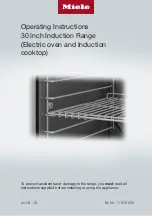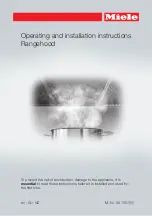
Surface Cooking
Lighting Instructions for
Standing Pilot Model
RGB524PN
The surface burners on this range
have standing pilots that must be lit
initially. To light them:
1. Be sure surface burner control
knobs are in the OFF position.
2. Remove the grates and lift the
cooktop up (see page 16).
3.
Locate the two pilot ports and
light each of them with a match.
Note: If the pilot is too high or low,
you can adjust it. See page 28.
4. Lower the cooktop. Your surface
burners are now ready for use.
5. Observe lighted burners.
Compare the flames to pictures
on page 22. If any flame is
unsatisfactory, call for service.
Lighting Instructions for
Electric Ignition Models
RGB524EN, RGS525GEN,
RGB528EN, RGB528GEN,
RGB628GEN
Surface burners on these ranges are
lighted by electric ignition, ending
the need for standing pilots with
constantly burning flames.
In case of a power outage, you can
light the pilotless ignition surface
burners on your range with a match.
Hold a lighted match to the burner,
then turn the knob to the LITE
position. Use extreme caution when
lighting burners in this manner.
8
Surface burners in use when an
electrical power failure occurs will
continue to operate normally.
Surface Burner Controls
The knobs that turn the surface
burners on and off are located on
the control panel in front of the
burners.
The two knobs on the left control
the left front and left rear burners.
The two knobs on the right control
the right front and right rear burners.
To Light a Surface Burner
Electric Ignition
Shown
Electric Ignition Models
Push the control knob in and turn
it to LITE. You will hear a little
clicking noise—the sound of the
electric spark igniting the burner.
Standing Pilot Model
Push control knob in and turn it to
HI position. The burner should
light within a few seconds.
After the burner ignites, turn the
knob to adjust the flame size.
Flame will be almost horizontal
and will lift slightly away from the
burner when the burner is first
turned on. A blowing or hissing
sound may be heard for 30 to 60
seconds. This normal sound is due
to improved injection of gas and air
into the burner. Put a pan on the
burner before lighting it, or adjust
the flame to match pan size as soon
as it lights, and the blowing or
hissing sound will be much less
noticeable.
Note:
●
Do not operate a burner for
extended periods of time without
having cookware on the grate.
The finish on the grate may chip
without cookware to absorb the
●
Check to be sure the burner you
turned on is the one you want to use.
●
Be sure the burners and
are
cool before you place your-hand, a
pot holder, cleaning cloths or other
materials on them.
How to Select Flame Size
Watch the flame, not the knob, as
you reduce heat.
The flame size on a gas burner
should match the cookware you
are using.
I
NEVER LET THE FLAME
EXTEND UP THE SIDES OF
THE COOKWARE. Any flame
larger than the bottom of the
cookware is wasted and only
serves to heat the handle.
When using aluminum or
aluminum-clad stainless steel pots
and pans, adjust the flame so the
circle it makes is about 1/2 inch
smaller than the cookware’s bottom.
When boiling, use this same
flame size—1/2 inch smaller than
the bottom of the cookware—no
matter what the cookware is made
of. Foods cook just as quickly at a
gentle boil as they do at a furious,
rolling boil. A high boil creates
steam and cooks away moisture,
flavor and nutrition. Avoid it except
for the few cooking processes
that need a vigorous boil.









































